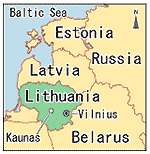(26)Victims of Chernobyl by Chieko Chiba
On August 9, 2007, the anniversary of the atomic bombing of Nagasaki, 200 people gathered along the Nemunas River in Kaunas, Lithuania to take part in a ceremony that featured floating lanterns, the very first such ceremony in the Baltic States.
Under a beautiful sky, 170 colorful handmade lanterns were put on display, with messages of peace written by children and adults. There was also a photo exhibition of the bombings of Hiroshima and Nagasaki and participants folded paper cranes, played music, and demonstrated the sport of "kendo." It was not only the first time floating lanterns have appeared in that region, it was perhaps the first lantern ceremony that involved victims of the Chernobyl disaster.

Colorful lanterns with messages of peace. The lanterns were set afloat on the river on August 9, 2007.
Chieko Chiba
A Japanese teacher and resident of the city of Kawasaki in Kanagawa Prefecture. She is a staff member of the Estonia-Chernobyl Hibakusha Fund, which was founded in 1990 by peace activists and university professors in Japan after interactions with a young Estonian man who was a victim of Chernobyl.
The Republic of Lithuania is a small country facing the Baltic Sea, about 1/6 the size of Japan with a population of 3.4 million. After World War I, it became independent from the Russian Empire, but after World War II, it was absorbed by the Soviet Union. Then, in 1990, it again became a sovereign state along with neighboring nations Latvia and Estonia. (These three countries make up the Baltic States.)
In 1986, when the accident at Chernobyl occurred, Lithuania was part of the Soviet Union and about 20,000 people from the Baltic States, including 6000 Lithuanians, were engaged in decontamination efforts and exposed to radiation.
Auguste Juraskaite, who organized the lanterns ceremony, is working as a volunteer in support of Chernobyl sufferers of Lithuania. She studied Japanese at a university in Japan for one year and, during her stay, she served as an interpreter when victims of Chernobyl came to Hiroshima. After returning to Lithuania, she held a memorial event on August 6, the day of the bombing of Hiroshima, that involved 4000 paper cranes and she returned to Japan to deliver these cranes to the Children's Peace Monument in Hiroshima Peace Memorial Park on October 25, the date of Sadako Sasaki's death. Auguste is a fierce opponent of nuclear weapons and a passionate advocate for peace.

At the lantern ceremony, when the sun set, the lanterns were lit and formed a glowing ring. They were then carried to the river, one by one, and set afloat, where they created a chain of light.
After I returned to Japan, I received a picture from Auguste. It showed her smiling in front of a thriving young paulownia tree that was given to her by Suzuko Numata, an active A-bomb survivor of Hiroshima.
Hiroshima and Kaunas may be two cities separated by a great distance, but Hiroshima's experience of the atomic bomb has firmly taken root in this Lithuanian city.